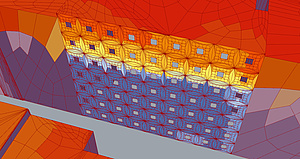In the planning process of buildings an early and integrative planning guideline is required to successfully implement Building-Integrated Photovoltaics (BIPV). Currently existing shortcomings are a lack of tools and a lack of a set of rules that can be easily applied in order to support especially those planners at an early stage who are not experienced in PV.
VITALITY aims though at developing design rules and parameter areas for technically founded planning to be applied in exemplary use-cases with an urban context. Further, the influence of BIPV on further planning parameters of buildings (like thermal comfort, electrical yield) are evaluated. The usability and relevance for Building Information Modeling (BIM systems) will play an essential role in the project.
According to the definitions of Climate Targets of the European Union (2009, 2011 and 2015) the area-wide implementation of BIPV is a must. At the same time the European Building Directive foresees the compulsory implementation of BIPV or similar active energy generation measures. These developments require strong efforts in terms of simplifying and enabling the consideration of BIPV in the planning process of buildings and urban districts
The Austrian Technology Platform Photovoltaics (TPPV) has defined in its position paper 2014 the integration of BIPV in the planning of new buildings as an important research topic and central cornerstone to foster the Austrian BIPV market.
VITALITY addresses the elaboration of tools for an integrative planning process and offers though an important step in the right direction. The results of the project are a set of numerical but simplified rules that allow a refined BIPV planning already during the design process. The project analyses design criteria and standardization and transforms them into simplified models. Prototype buildings are planned in a parametric way, simulated in terms of thermal and light management, and they are examined with regard to their thermal, electrical and BIPV expert planning. Planning interfaces and planning information flows are considered, and the relevance for BIM-systems is displayed.
As a result, the simplified models and parametrical simulations lead to establish design rules for an early planning stage, respecting the typical needs of planners for both planning flexibility and precision in terms of the expected BIPV-yield.
Projectduration:
February 2017 – January 2019
Financing:
Austrian Research Agency (FFG)
Climate and Energy Fund
Projectteam:
AIT Austrian Institute of Technology (Konsortialführung): Tim Selke, Marcus Rennhofer, Thomas Schlager, Sean Phillipp
TU Graz: Institut für Gebäude und Energie,Sebastian Sautter
TU Graz: Institut für Architektur und Medien, Martin Kaftan
EURAC: Marco Lovati
Lund Universität: Jouri Kanters
teamgmi: Anita Preisler
ATB-Becker: Gernot Becker
Projectpartnerships:
AIT Austrian Institute of Technology GmbH (lead management) – Austria
EURAC research Bozen – Institute für Erneuerbare Energie – Italy
Lund University – Faculty of Engineering, Department of Architecture and Built Environment – Sweden
teamgmi Ingenieurbüro GmbH – Austria
ATB-Becker e.U. – Austria

